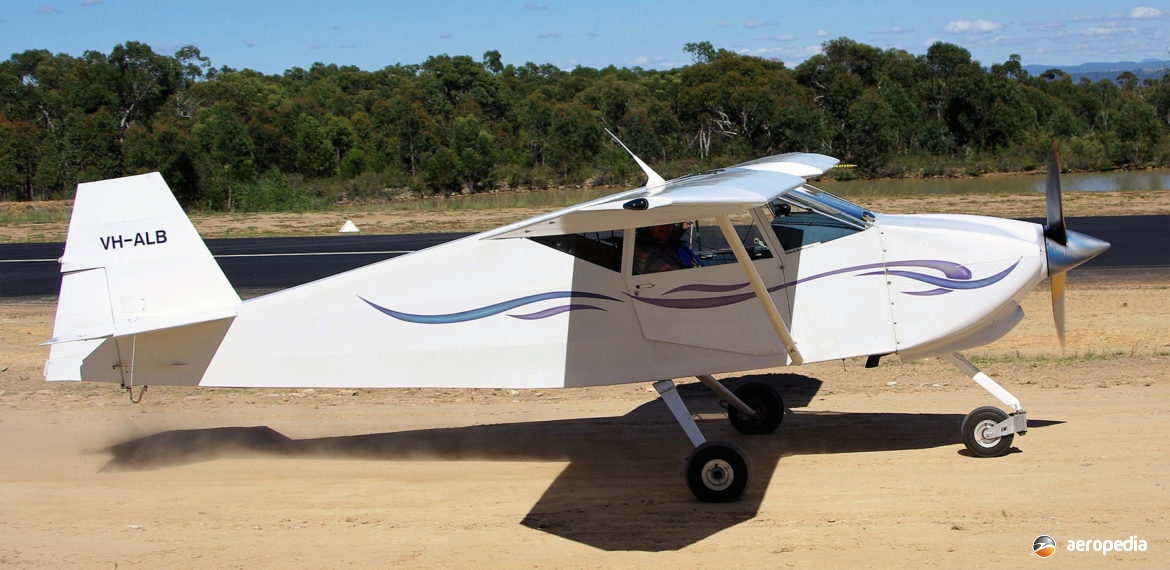Photograph:
Wittman Tailwind VH-ALB (c/n 99-1118) taxiing at Wedderburn, NSW (David C Eyre)
Country of origin:
United States of America
Description:
Two-seat light sport cabin monoplane
Power Plant:
One 75 kw (100 hp) Continental A100 four-cylinder horizontally-opposed air-cooled engine
Specifications:
- Wingspan: 6.86 m (22 ft 6 in)
- Length: 5.87 m (19 ft 3 in)
- Height: 1.73 m (5 ft 8 in)
- Wing area: 8.36 m² (90 sq ft)
- Max speed at sea level: 265 km/h (165 mph)
- Max cruising speed: 257 km/h (160 mph)
- Max rate of climb at sea level: 275 m/min (900 ft/min)
- Service ceiling: 4,876 m (16,000 ft)
- Range with max payload at 3,050 m (10,000 ft), no reserves, at 257 km/h (160 mph): 965 km (600 miles)
- Empty weight: 318 kg (700 lb)
- Loaded weight: 590 kg (1,300 lb)
History:
Steve Wittman, a well-known American racing pilot since the 1920s, designed a number of racing aircraft and, due to the popularity of his designs, several were made available for amateur construction. The most popular of these was the Tailwind. The Tailwind, the prototype of which was first built in 1953, proved to be so successful that sets of plans and prefabricated components were marketed for amateur builders, and many hundreds have been built throughout the world.
Initially the type could be built in two variants, the W-8 with a normal tailwheel undercarriage, or the W-9 with a tricycle undercarriage. In more recent years a developed slightly larger variant known as the W-10 became available. Most builders used the 119 kw (160 hp) Lycoming O-320-BA engine but other engines installed have included the 63 kw (85 hp) Continental C-85, 86 kw (115 hp) Lycoming O-235, and 104 kw (140 hp) Lycoming O-290.
The Tailwind was a side-by-side two-seat, high-wing, strut-braced cabin monoplane. The wing consisted of two separate panels, each incorporating wooden spars and ribs, internal wire bracing, and plywood covering. The ailerons and flaps were of steel-tube construction and fabric covered. The fuselage was of chrome molybdenum steel-tube structure, fabric covered. A cabin door was incorporated on each side, and the empennage, like the fuselage, was built up of welded steel tube, and fabric covered. The main undercarriage incorporated round spring steel main legs. Normally a 90.9 litre (20 Imp gal) fuel tank was installed in the fuselage behind the firewall.
A number of Tailwinds have been constructed and registered in this region over the years and registrations allotted to these have included: VH-WAT (c/n V11); VH-BDJ (c/n N48); VH-OWS (c/n V15); VH-MGO (c/n W28); VH-SLA (c/n V29); VH-JPB (c/n W27); VH-TPR (c/n V930); VH-ALB (c/n 99-1118); VH-YET (c/n 940) to its owner at Kirwan, QLD in June 2011, this being a W-10; VH-WIQ² (c/n W2015) on 1 December 2015 to its owner at Boonah, QLD, also a W-10; and VH-TWQ (c/n 05-1305) on 9 May 2018, a further W-10.
Examples registered in New Zealand include ZK-RET (c/n AACA/386).

